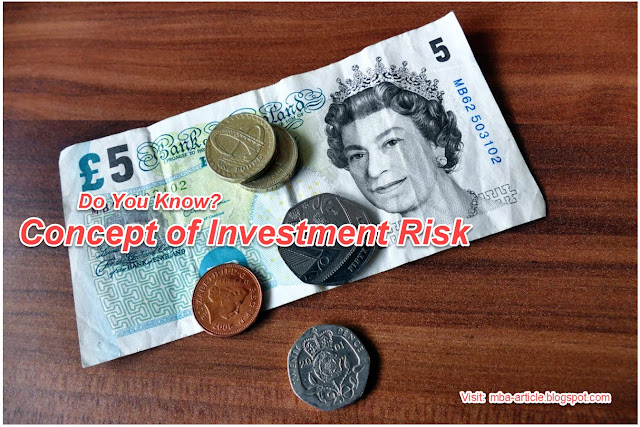Concept of Investment Risk - Risk analysis of investment is one of the most complex, controversial and slippery areas in finance. Business decisions are generally made under conditions of uncertainty rather than under conditions approaching certainty. In fact, both risk and uncertainty are the extreme end of the same spectrum.
Concept of Investment Risk
The word “risk” shall be used to connote the idea of the twofold possibility of loss or gain. Some people things that investments are inclined to give emphasis to possibilities of loss but it is a negative pessimistic and depressing approach. But some people things that investments are inclined to give emphasis to possibilities of gain which is optimistic.
In formal term, risk associated with a project o investment may be defined as the variability that is likely to occur in the future returns or investment. Therefore, we relate risk to variability of return i.e., the degree to which the return on an investment varies unpredictably.
Categories of Risk
Shortly speaking risk is the variability of return from an investment. Returns on investment may vary from the expectation of the investors. So risk may be defined as the likelihood that the actual return from an investment will be less than the expected return. Depending upon the elements of risk, it may be broadly divided into two categories like systematic risk and unsystematic risk.
Some elements of risk that are external to the firm cannot be controlled and effect large numbers of securities are the sources of systematic risk. On the other hand, controllable, internal factors somewhat peculiar to industries and/or firms are referred to as elements of unsystematic risk. The risk associated with macro, pervasive factor such as a national economy is called systematic risk. On the other hand, the micro risks associated with factors particular to a company are called unsystematic or unique risk. Investment manager can do little about systematic risk, although they can do much about unsystematic or unique risk.
Some elements of risk that are external to the firm cannot be controlled and effect large numbers of securities are the sources of systematic risk. On the other hand, controllable, internal factors somewhat peculiar to industries and/or firms are referred to as elements of unsystematic risk. The risk associated with macro, pervasive factor such as a national economy is called systematic risk. On the other hand, the micro risks associated with factors particular to a company are called unsystematic or unique risk. Investment manager can do little about systematic risk, although they can do much about unsystematic or unique risk.
| Categories of risk | Sources of risk |
| Pervasive risk |
|
| Systematic risk |
|
| Unsystematic risk |
|
Pervasive Risk
Some risks are pervasive and applicable to all investments.
Purchasing power risk:
Purchasing power risk is the uncertainty of purchasing power of the amount to be received. It refers to the impact of inflation or deflation on an investment. Rising prices on goods and services are normally associated with what is referred to as inflation. On the other hand, falling prices on goods and services are termed deflation. Purchasing power risk or inflation risk has received considerable publicity in recent years. When investor holds his surplus funds in the safety deposit box, he suffers from purchasing power risk. The risk of loss of income or principal because of decreased purchasing power of money is also known as purchasing power risk. For some investors, purchasing power risk is very important. Individuals or institutions using their income to buy goods and services are greatly concerned over any changes in the purchasing power of their income. Investors who fear inflation usually invest partially in common stocks and real estate with the hope that will rise in value. Rationale investors should include in their estimate of expected return, an allowance for purchasing power risk, in the form of an expected annual percentage change in prices.
Default risk:
Another form of systematic risk is default risk. This type of risk arises because firms may eventually go bankrupt. Default risk unverifiable or uncontrollable as it is systematically related to the business cycle affecting all most all investment even though some default risk may be diversified away in a portfolio of independent investments.
Exchange rate risk:
The chance that return will be affected by changes in rates of exchange because investments have been made in international markets whose promise to pay dividends, interest, or principal is not denominated in domestic currency risk or exchange risk. Exchange rate risk is the uncertainty due to the determination of an investment in a country other than that of the investor’s own country. The likelihood of in
curring this risk is becoming greater as investor buy and sell assets around the world, as opposed to only assets within their own countries.Political risk:
Also called country risk, political risk is the uncertainty due to the possibility of major political change in the country where an investment is located. The chance that returns will be affected by the policies and stability of nations is termed political risk. The dander of debt repudiation or failure to meet debt service, expropriation of assets, differences in taxes, restrictions on repatriating funds, and the prohibition against exchanging foreign currency into domestic currency are typical political risks.





